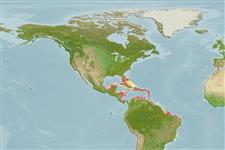Common names from other countries
Classification / Names / Names
Common names | Synonyms | Catalog of Fishes (gen., sp.) | ITIS | CoL | WoRMS
Environment: milieu / climate zone / depth range / distribution range
Ecology
Sessile; brackish; depth range 1 - 5 m (Ref. 108813). Tropical
Western Central Atlantic: Caribbean.
Length at first maturity / Size / Weight / Age
Maturity: Lm ? range ? - ? cm
White; crispy and crumbly mass. With elevated fistules-oscular tubes. Massive, papillated or tube.
Combination depth range: min from literature, max from estimate.
Life cycle and mating behavior
Maturity | Reproduction | Spawning | Eggs | Fecundity | Larvae
Members of the class Demospongiae are hermaphroditic. Life cycle: The zygote develops into parenchymella larva (free-swimming) before settling down on a substrate where it grows into a young sponge.
Zea, S., T.P. Henkel and J.R. Pawlik. 2009. (Ref. 81728)
IUCN Red List Status (Ref. 130435)
CITES status (Ref. 108899)
Not Evaluated
Not Evaluated
Threat to humans
Harmless
Human uses
| FishSource |
Tools
More information
Age/SizeGrowthLength-weightLength-lengthMorphologyLarvaeAbundance
Internet sources
Estimates based on models
Preferred temperature
(Ref.
115969): 26.2 - 28.3, mean 27.2 (based on 299 cells).
